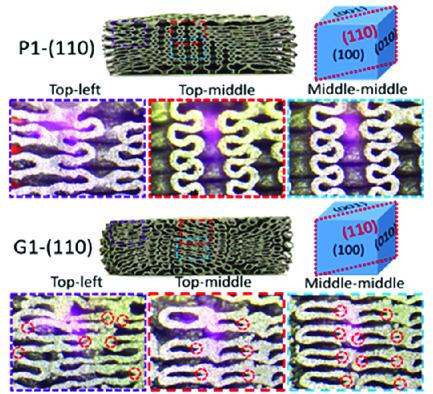当前位置:
X-MOL 学术
›
Steel Res. Int.
›
论文详情
Our official English website, www.x-mol.net, welcomes your feedback! (Note: you will need to create a separate account there.)
Energy Absorption and Deformation Behavior of 3D Printed Triply Periodic Minimal Surface Stainless Steel Cellular Structures under Compression
Steel Research International ( IF 2.2 ) Pub Date : 2020-11-03 , DOI: 10.1002/srin.202000411 Yingjing Liang 1 , Wei Zhou 1 , Yijie Liu 1 , Zhanshuo Li 1 , Yang Yang 2 , Huifeng Xi 3 , Zhigang Wu 1
Steel Research International ( IF 2.2 ) Pub Date : 2020-11-03 , DOI: 10.1002/srin.202000411 Yingjing Liang 1 , Wei Zhou 1 , Yijie Liu 1 , Zhanshuo Li 1 , Yang Yang 2 , Huifeng Xi 3 , Zhigang Wu 1
Affiliation

|
This article investigates the energy absorption performance and deformation mechanism of 316L stainless steel (SS316L) triply periodic minimal surface (TPMS) cellular structures fabricated by a selective laser melting (SLM) technique. The as‐built specimens are subjected to abrasive blasting treatment to improve the surface quality of the printed parts, in order to reveal the true surface and mechanical characteristics of the TPMS structures. It is found that the P‐type structure outperforms the G‐type structure with a higher energy absorption capability at low relative densities (<0.35). The macroscopic examination of these micro‐architectures reveals that the P‐type structure develops a rapid local cell deformation following the diagonal shear geometry on the face sheet, whereas the G‐type structure experiences continuous strain hardening along the stress plateau and deforms in a gradual manner during compression. The apparent strain hardening effect of the G‐type structure is caused by the development of many macro‐localities with extreme geometry distortion and cell wall self‐contacting during compression. The findings in this study may provide valuable insight into design, fabrication, and post‐fabrication treatment of metallic TPMS structures for the applications of high compression performance.
中文翻译:

压缩下3D打印的三重周期周期性最小表面不锈钢蜂窝结构的能量吸收和变形行为
本文研究了通过选择性激光熔化(SLM)技术制造的316L不锈钢(SS316L)三重周期性最小表面(TPMS)蜂窝结构的能量吸收性能和变形机理。对制成的试样进行喷砂处理,以改善印刷零件的表面质量,以揭示TPMS结构的真实表面和机械特性。发现在较低的相对密度(<0.35)下,P型结构的性能优于G型结构,具有更高的能量吸收能力。对这些微结构的宏观检查表明,P型结构会遵循面板上的对角线剪切几何形状而迅速发展出局部单元变形,而G型结构沿应力平台经历了连续的应变硬化,并在压缩过程中逐渐变形。G型结构的明显的应变硬化效应是由许多宏观区域的发展引起的,这些宏观区域在压缩过程中具有极端的几何变形和细胞壁自接触。这项研究的发现可能会为金属TPMS结构的设计,制造和后加工处理提供有价值的见解,以用于高压缩性能的应用。
更新日期:2020-11-03
中文翻译:

压缩下3D打印的三重周期周期性最小表面不锈钢蜂窝结构的能量吸收和变形行为
本文研究了通过选择性激光熔化(SLM)技术制造的316L不锈钢(SS316L)三重周期性最小表面(TPMS)蜂窝结构的能量吸收性能和变形机理。对制成的试样进行喷砂处理,以改善印刷零件的表面质量,以揭示TPMS结构的真实表面和机械特性。发现在较低的相对密度(<0.35)下,P型结构的性能优于G型结构,具有更高的能量吸收能力。对这些微结构的宏观检查表明,P型结构会遵循面板上的对角线剪切几何形状而迅速发展出局部单元变形,而G型结构沿应力平台经历了连续的应变硬化,并在压缩过程中逐渐变形。G型结构的明显的应变硬化效应是由许多宏观区域的发展引起的,这些宏观区域在压缩过程中具有极端的几何变形和细胞壁自接触。这项研究的发现可能会为金属TPMS结构的设计,制造和后加工处理提供有价值的见解,以用于高压缩性能的应用。


























 京公网安备 11010802027423号
京公网安备 11010802027423号